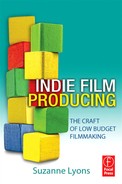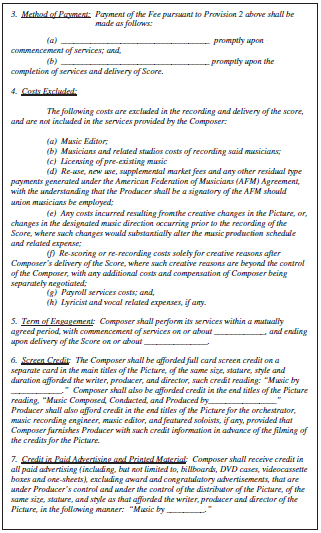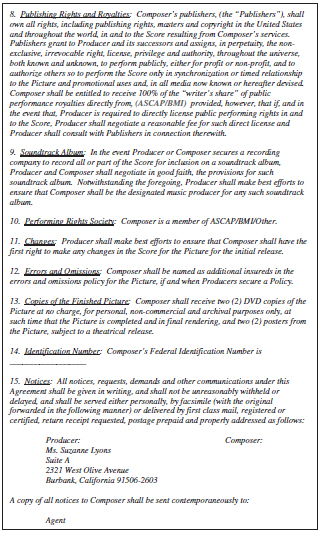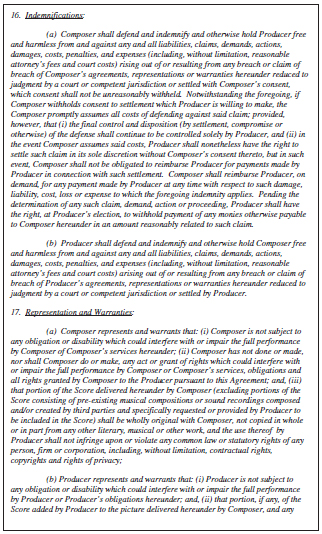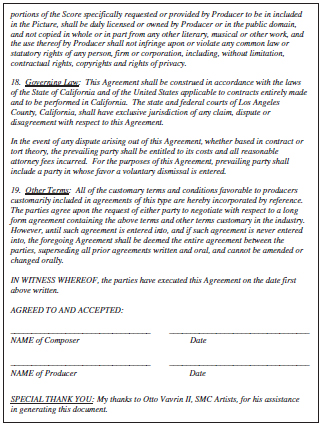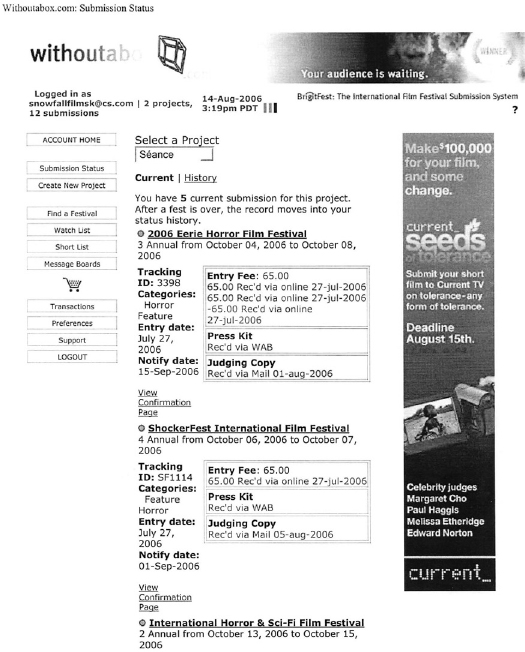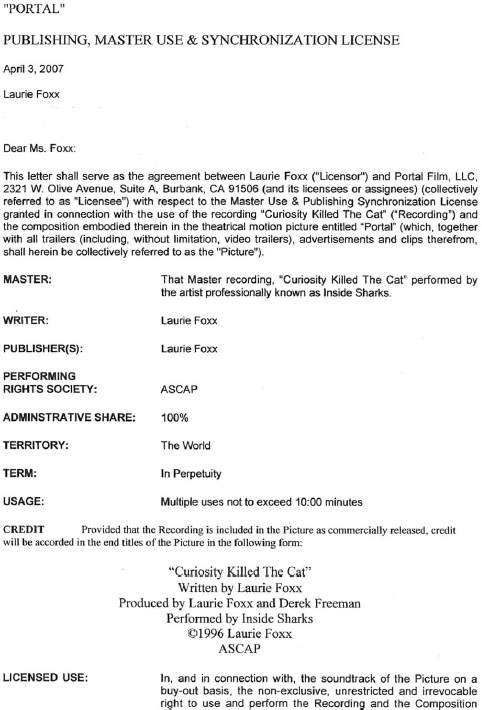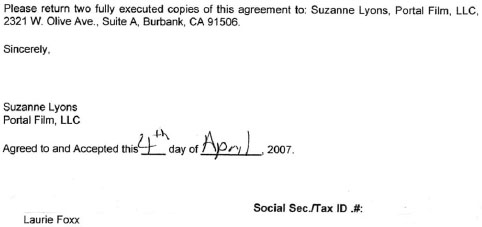Wrap-Up and Postproduction
The 14-day shoot is over!! It was a great shoot, and – as much fun as it was to be on set and location – it’s sure nice to be back in my office again. It’s nice when all your hard work has paid off – especially when you know that you have everything you need to move on to postproduction and delivery. So let’s take a look at all the areas that you will need to handle during this next stage.
WRAP PARTY
The first order of business is the wrap party. It is usually scheduled immediately following principal photography because the cast and crew are still available. And you want as many people as possible to be able to attend so that everyone can have a chance to enjoy themselves, be acknowledged, and do a little networking that they didn’t have time for during the shoot. I went over all the logistics for the wrap party in Chapter 10, but I want to highlight a couple of points.
Kate and I made certain to greet as many people as possible and personally gave them their drink tickets. Throughout the evening, we made a point of acknowledging everyone for the great job they did on the film. We booked great spots for our parties, ordered excellent food, had hundreds of stills from the film running on a loop on all the TV sets available, and played great music. The last point I want to stress is that it’s your party, too. So have fun, relax, and dance! You’ve worked hard – really hard – and it’s your time to chill and have a ball. You’ve earned it!
LINE PRODUCER’S WRAP-UP
On the Monday after production Mike moved back into my office again. You will need your line producer for a full week after you wrap. Mike started immediately finishing up any final payments that were due. He made sure that he was in touch with the keys to ensure that any rentals were promptly returned. You don’t want any surprises in that department. Those companies have your credit card number, and the fine for late returns is insane.
Another job that your line producer will be doing is working on the SAG delivery book. This task is pretty intense, as the delivery list includes all the SAG actor’s contracts, production reports, call sheets, final cast list, final cost reports, signatory letters, and more. Make sure that you make a copy of the entire delivery book before you send it off to SAG, because if it happens to get lost or if they have questions about anything, then you have a copy at your fingertips. Also, you want to get your deposit back from SAG because you are moving into postproduction and you’ll need that money. When they receive their delivery book, you should make the request for the refund of your deposit.
Another item that Mike was busy working on is the wrap book. I love this book. It includes the final version of the script, the shooting schedule, crew list, cast list, vendor list, location list, call sheets, and production reports. In fact, when you’re interviewing line producers, make sure that they include a wrap book as part of their service. Mike made copies for me, Kate, and our director.
EDITOR’S ASSEMBLY
Also happening during the first week following production is your editor’s assembly. Your editor is doing this continually during the shoot, but now he or she gets a full week to complete the assembly before the director joins him or her.
COPYRIGHT TRANSFER
If you didn’t have time to do the copyright transfer during principal photography, now is the perfect time. You are back in your own office now with access to your files, your computer, and everything you need to do the transfer.
You can go online and pull down the copyright paperwork. There is nothing special or challenging about it. In fact, it’s the same exact paperwork that the writer originally used when he or she did the copyright on the screenplay. The only difference now is that in the section asking who the author is, it will no longer be the writers (for instance, Kate Robbins and Jill Garson); it will be Candy Stripers, LLC. You have your short-form assignment that I talked about in Chapter 3, so you have the right to transfer the project from the writer to the company. As long as you have paid the writer the purchase price, which happened on the first day of principal photography or before, you are good to go.
This transfer is all part of the “chain of title,” which you will need for delivery; put it in your schedule so that it happens at this time. It may take a year to get it back from the government, but don’t worry about that. All you need for delivery is the proof that you have sent off the paperwork to the government copyright agency. Just remember this: no chain of title, no movie.
FILM WEBSITE
I didn’t take full advantage of this opportunity. Today, the Internet is vital. It’s how the world communicates. If you haven’t put a website up yet, do so at this stage. You now have access to some great stills. You have your synopsis and possibly even a trailer and a press release.
HIRING FOR POSTPRODUCTION POSITIONS
In most budgets, you would have the luxury of having a postproduction supervisor, but at $200,000, I just couldn’t justify it. Also, it was an area that I wanted to know more about. I wanted to save as much money as possible, yet have high-quality films to give our investors a better chance for a return on their investment. This seemed like a way that I could save.
During production, I started getting suggestions and asking around about great people for the post positions. I needed a sound designer, a composer, and a color correction expert: three very important positions. I wanted the best in the business, but I didn’t have a lot of money for the jobs.
Sometimes you can find people who have held studio positions and are now opening their own company and are looking for new clients. They are far more inclined to lower their prices just to get the word of mouth started. Also, another way that we got quality people for a reasonable price was by saying that we were willing to extend the time period that they would have to complete the job; that way, they were able to take on their higher-paying clients and still fit us in during their off hours.
When it came to doing the spotting for our color correction, my director, my DP, and I were often called to come in and view the scenes at midnight. And Saturday morning was usually the time I did the spotting with the composer and sound designer. It was well worth it because I was able to cut thousands off their price.
Regarding deal memos: make sure to carefully review a list of delivery items (which you can get from a sales agent) before you type up any contracts. Even if you are planning to self-distribute, you will need to do this. You don’t want to go back months later and say, “Oh, sorry, but I didn’t know that I would need such and such, would you mind doing it?” Having everything that you will need to deliver your film in the deal memos for your sound designer, your color correction artist, and your composer will save you time and money and prevent embarrassment. In fact, in some of our composers’ deal memos, we included music for the film trailer as part of the responsibilities. Ordinarily, your sales agent will handle the trailer, but if you want to cut down on the sales agent’s expenses or if you plan on self-distributing your film, then I would certainly include the music for the trailer in your composer’s deal memo.
Figure 11.1 shows a deal memo that was used for our composer on a couple of our films.
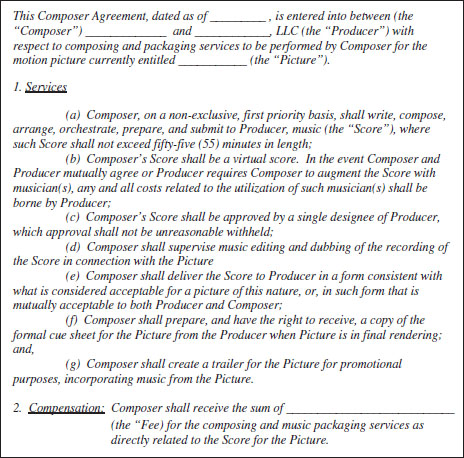
FIGURE 11.1
I have known producers who have joined ASCAP (American Society of Composers, Authors, and Publishers) or BMI (Broadcast Music Incorporated) in order to receive money when their film is played, by either owning the rights to the score and/or songs or sharing in the rights. I think if you are using a new composer, he or she may be more willing to include this in the deal with you. But in our case, we were using an experienced composer, and we were getting him at a great price, so I really didn’t feel it was at all fair to take a percentage of his future earnings.
Here are the items from our sound designer’s deal memo on both Séance and Portal:
Re-recording mix & sound designer
Foley
ADR includes one 5-hour session; after the one 5-hour session, ADR will cost $65.00 per hour.
Reel Changes (new Picture) there will be a new $200.00 per-hour charge for resyncing audio to new picture.
Delivery:
1. 5.1& Lt/Rt Feature & Trailer English Language Printmaster
2. 5.1 & Lt/Rt Feature & Trailer M&E
3. D/M&E (Dialog, Music & Effect Stems) Feature & Trailer – Stereo Parallel Tracks
The audio on the DVD is SDII format, continuous multiple mono files at 48k, 24 bit. They include Head Tones and 2-pops.
Payment Schedule – Sound Rage Recordings:
First Payment: Due at signing of this agreement
Second Payment: Due on 9/15/06 (completion of sound design)
As with so many of our cast and crew on our films, Kate and I were blessed with an amazing sound designer, Marcus Blanchard. What we learned from Marcus was to be extremely aware of noise. Our hotel in Portal was fantastic in many ways, but it was right on the highway, and even with the night shoots, the noise from the trucks was constant. Our editor brought this to our attention a number of times as well. The ADR on Portal was double the cost of Candy Stripers and Séance combined. In Candy Stripers, we had a problem with the shoes that our candy stripers wore. The shoes were constantly squeaking, and that had to be fixed in post. When you need to duplicate sounds it’s very costly.
Here are the items that were included in our deal with our color correction artist:
Inclusive:
HD Conform to 24P
HD Color Correction @ 40 hours
Layoff to D5
DVD Screener Master
Client provides the following:
24fps EDL & 24fps offline reference
Main & End Titles (Adobe Illustrator and/or pre-build 24p QuickTime/Video Element)
Production Representative for color and conform sign-off
HD Services Terms:
Full Primary and Secondary color-correction is inclusive in price
Client will provide “off-line” reference for picture, titles, etc.
Client must provide an accurate EDL for conforming
Payment Schedule: in advance to secure discounted rate
Color Correction beyond 40 hours will be billed @ $350/hour
VFX outside included elements will be bid accordingly
Editorial changes beyond the scope of the offline/EDL will be billed @ $250/hour
Any questions or items that you may wish to negotiate, please contact Cranium Filmworks L.A.
As I’ve mentioned, make sure that you check out a current detailed delivery list and be certain to include in the deal memos any and all requirements on that list that are related to the composer, sound designer, and color correction expert.
DIRECTOR’S CUT
Once the editor has his or her week to finish up the assembly, he or she is ready for the director to join him or her in the editing suite. At this budget level, our director had two weeks to complete the director’s cut. On my bigger-budget films, it varied drastically, but two weeks is absolutely fine in the ultra-low-budget world. As the producer, you stay away from the editing suite at this time. The editor had a week to do the final assembly, and now the director has two weeks, so you get to do all the other items that need seeing to. During the director’s cut, the editor will use what is called temp music so that you will get a true feel for how the final project will look.
AUDIENCE TESTING
While the director and editor are working together, you get to plan and book the theatre for the audience testing. I wanted to hold it immediately after the director’s cut was complete because I had only an additional week or so with the editor. So I booked it for late Monday afternoon, and I sent out the email invitations early the week before. I booked a theater that held 35 people and I wanted at least 15 or 20 of them to be the perfect demographic for the film. I wanted the rest of the people to be from different areas of the entertainment industry. I thought that would be a good mix of people to get an honest account of what worked and what didn’t about the film.
In some cases, during the audience testing, we just gave people the forms with a pen and then gave them a certain amount of time at the end to fill them out. Then we collected them and that was it. In other situations, we asked people to stay after we had collected the forms to discuss certain aspects of the film that we wanted to get further information on. We had a prepared list of questions ready. It just depends on your film and how close you feel it is to being ready. If it’s close, then the form is enough, but if you know that there are problems, be sure to plan for a discussion with your audience at the end of the testing. Here is the information that was in the email that went out about the Portal audience testing screening:
Dear Friends:
We are holding the Audience Testing for Portal on Monday, February ![]() at Raleigh Studios in the Mary Pickford Screening Room (Raleigh Studios) from 4:00 to 6:00 p.m.
at Raleigh Studios in the Mary Pickford Screening Room (Raleigh Studios) from 4:00 to 6:00 p.m.
We are looking to fill seats with our target audience, which is aged 18–30 years old and has seen three out of six of the following films:
The Undead
The Hills Have Eyes
Saw
Dawn of the Dead (remake)
Dark Water
Boo
If you or someone you know fits this demographic and would be available to come to the Audience Testing, we’d love to have you.
We have limited seating, so if you would like to attend, please call me (Kate) by January 29 to put your name on the list. My direct line is (310) 555-5555.
The address is 5300 Melrose Avenue, Los Angeles, 90038. There is free parking on the street for a two-hour period or at meters, which go up to four hours. Parking is also available in the Raleigh Studios garage for a fee of $5.00.
Thanks for your help. Hope to see you there.
Yours as always,
Kate Robbins and Suzanne Lyons
WindChill Films
As you may have noticed on the invitation, we made a point of mentioning our target audience. We wanted a number of people to be between 18 and 30 years old because we felt that this age range was our demographic. Also, we wanted to make sure that we had people in the audience who were true fans of this genre. That is why we mentioned six films that were similar in nature and requested that they should accept our invitation only if they had seen at least three of these films.
Our audience testing form is the result of a few different forms I have seen over the years. We took the best of each one and created our own. Feel free to use it for your own films. Figure 11.2 shows a copy of the form we used.
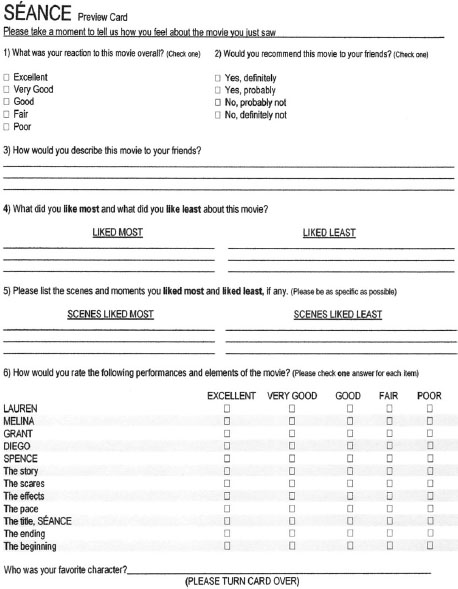
FIGURE 11.2
PICK-UP DAY
Pick-up day is something that you want to be sure to include in your budget. When you have a shoot as limited as 14 days there’s a chance that something may be missed. Sometimes it as simple as needing a few transition shots, like a hand turning a door knob. Or in the case of my film, Undertaking Betty, the audience testing revealed a question about the relationship between Betty and her husband. To fix the problem we had to book a full day and call back one of the actors. If you end up not needing a pick-up day, that’s excellent, but plan for it just to be safe. In the case of Candy Stripers, we needed a full day. On Séance, we didn’t need one at all, and on Portal, we required only a half day of shooting.
On Portal, we were especially lucky because we were able to use our director’s office for the shoot. Geoff Schaaf was our director, and he had a great office space – and the best part is that it was free! When we picked up the camera we had used for the shoot, the gentleman in charge at Sim Video said that there was no charge. Amazing. The few shots we needed were done in less than four hours. Quick and easy.
As soon as we finished, I called Sim Video and asked the assistant what her boss’s favorite drink was. She gave me the name of his favorite scotch and I headed to Trader Joe’s and bought the scotch with a nice box for it and a thank-you card. I dropped it off at his office, and by the time I got back to my office, there was a message from him on my machine that was amazing. He was so moved by the fact that I had bought and dropped off a gift. His message nearly brought me to tears. He had saved us a day’s rental on the camera, and I thought it was important to acknowledge his kindness.
I know that when you are in the middle of producing your movie, you may feel that there are a ton of details to handle, but it’s important to stay conscious and present and remember to thank and acknowledge people on a constant basis.
LOCK PICTURE
After the audience testing, it’s great to sit down with your editor and director and discuss the responses you’ve received. Once you are all in agreement, the director goes back into editing for a few days to make the changes.
I remember that with Séance, there were only a few changes suggested, but everyone (I mean everyone) had the same thought: to get rid of the two emotional scenes toward the end of the film. I was so upset. Those scenes were fantastic. Award-winning! I had a really hard time agreeing. But if everyone was saying the same thing – “it slowed down the fantastic action adventure scenes where the killer ghost was chasing the girls through the dark creepy tunnels” – I had to surrender. My director and editor went back in to make the changes. Looking back, I wish I had set those scenes aside and had them-color corrected and saved them to put on the DVD as deleted scenes.
When you are happy and totally satisfied with the film, you do what’s called “lock picture.” The final editing is complete and it’s time to move on to your next phase of post: working with your composer, color correction artist, and sound designer.
SALES AGENTS AND FIRST ROUND OF FESTIVALS
If you have time to wait for all aspects of post to be complete before you start sending it off to sales agents (if you are going that route) and festivals, that would be excellent. However, we don’t always have that luxury. With Candy Stripers and Séance, we were so close to AFM and to some of the deadlines for the horror/thriller festivals that we had no choice. We had to send in the DVD from our locked picture. It had temp music, so it gave the feel of a completed film, even though it didn’t have the color correction and sound design.
In our attached letter to the festivals and to sales agents, we explained this fact and said that the moment we had the competed film, we would be forwarding it to them. Anyone running those companies is absolutely fine with that, and as it turned out, we had sales agents competing for our films. We also got into and won a number of film festivals. Our final version of the film was ready in time for our sales agent to take it to the market and in time to screen at the festivals in which we had been accepted.
We used WithoutABox.com to gather information for submissions to the festivals. Figure 11.3 is a list from a few of the festival where we submitted Séance.
FIGURE 11.3
MUSIC SCORE, SOUND DESIGNING, COLOR CORRECTION, SPOTTING, AND ADR
If your deal memos are complete by the time you do your audience testing, I would invite your composer, sound designer, and color correction artist to the screening. That way, they will get a sense of the project; better yet, they will also get to meet each other. In fact, I think it’s extremely important that your composer and sound designer communicate. I had a situation once where the composer was designing some of the sound effects as part of his score. It ended up conflicting with the effects that the sound designer was inserting. It’s very important that they are talking to each other.
As I mentioned earlier, in order to get a better rate, I gave them far more time to do the project, and often they were doing it in their off hours. So when it came to spotting, I was often sitting in a dark theater with my director and DP at midnight viewing the color-corrected scenes or checking up on the music or sound on the film early on a Saturday morning.
With ADR, you certainly don’t have to be there. But when it came to any of the lead roles, I made certain that I was there. On some of my bigger-budget films, I really made a point to be at ADR because, as the producer, I felt it was important for me to be available.
In the paperwork that your line producer receives from SAG, there is a sheet where you list any SAG actors who are doing ADR and how much they have been paid. They are paid the same rate that they were paid per day during the shoot. Usually, ADR is only a couple of hours (or less), but they are still paid for the day, which in our case was $100. When complete, this form should be mailed into SAG. In regard to your non-SAG actors, as you will remember from the cast deal memo, ADR (like the table read/wardrobe fitting) was included as part of their overall package.
ADDITIONAL SONGS
Kate and I had some great songs for our end-roll credits in all of our films. We had no money in the budget to pay for the rights to songs, but we were lucky in that we had people write songs that we could use during our endroll credits or in some cases, allow us to use their existing songs. They would be paid through ASCAP and BMI as the films aired around the world. There was no paperwork to do with ASCAP or BMI. So the only paperwork necessary was the deal memo with the artist. Figure 11.4 shows one of the deal memos used for our wonderful singer, Laurie Foxx, who also happened to be one of our actors on Portal.
FIGURE 11.4
FRONT-ROLL CREDITS (MAIN TITLES)
Chris Robbins, our “making of” producer and stills photographer, did the style design for the front-roll credits for Candy Stripers, Séance, and Portal. Unbelievable work! Really excellent. We didn’t have a lot of money, but we did have time, and that is what worked for us. Like the rest of the postproduction experts, we gave him the time to work on his off hours. So instead of two to three weeks, which would be the norm, everyone had two months.
Regarding the actual credits, Kate came up with a brilliant idea. To be absolutely safe, she went back to each of the lead actor’s deal memos and cut and pasted the section that said what order their name was to be placed in, then put all the information on one page. That way, you could see clearly exactly the order and placement of our cast in the front-roll credits. It was so easy. We also gave Chris the list and order of the other names and titles that would be needed for the front-roll credits.
Please be sure to check all the deal memos on all the actors just in case you’ve made any mistakes. When I was going over the list on Séance, I realized that I had used the wrong deal memo for one of the actors, who literally had one line in the movie. She is in the front-roll credits because in her deal memo it says, “Billing on a separate card in the mail titles (provided main titled credits are used and other cast member credits appear therein). Advertising Billing: Artist will be included in all paid advertising where the billing block appears.” Please take time and double- and triple-check your deal memos before they go out.
It was my fault, and I am so happy that I caught it before the credits were locked in. Also, just make sure that the way that the actors have signed their deal memos is in fact the way they want their names to appear in the credits. We have had to go back more than once because the actor, director, DP, or someone else has said, “I really want to use my middle initial” or “I really want you to use my nickname.” I try to get all that handled as people are signing off on their deal memo during soft prep and preproduction. But it’s always safe to do a double check.
Speaking of double-checking, as the producer, when the main titles are complete, be sure to look over the spelling, the placement, and the number of seconds each name is on screen and also check that all names are inside the required aspect ratio. Better to check now than to have a sales agent or distributor call and say that there are problems with the aspect ratio and therefore the titles are not acceptable. That would not only be painful – it would be costly.
In Candy Stripers, we chose not to do front-roll credits. The film had a really scary scene right off the bat and we thought it would diminish the impact to lay credits over that scene.
Here is the order for the main titles for Portal:
Windchill Films Presents
PORTAL
Lead actors’ names
Line Producer
Costume Designer
Production Designer
Music By
Editor
Director of Photography
Executive Producers (on a shared card)
Executive Producers (on a single card)
Produced By
Screenplay By
Directed By
END-ROLL CREDITS
If you think making your movie might be stressful, believe me, it’s nothing compared to the end-roll credits. Okay, maybe I’m exaggerating a bit – but not by much. This job may very well fall on your shoulders at this budget level, and it’s a job you want to take seriously, because people are very fussy about getting the credit they deserve – and rightly so. Everyone wants their name spelled correctly.
I think Kate and I spent a week just double-checking people’s names. Remember that in the investors’ subscription agreement, I had added a section where they printed exactly how they wanted their name in the credits. Be sure to do that with every deal memo. In fact, I suggest you have a special area where you ask specifically how they want their name spelled and then have them initial it.
If I am sounding a bit tense about this, it’s because I have reason to be. Until I learned to do this, I just assumed that the way people signed their deal memos and agreements was how they wanted to be listed in the credits. Never assume! You don’t have the money to keep going back to make changes, so know up front exactly what you need.
Also, be sure to include everyone. For example, our composer had outsourced some of the work to friends of his who were musicians in Switzerland. I had forgotten all about this until I was double-checking and going through every single deal memo and agreement related to the film.
Something to keep in mind is the list of people you want or need to place in the thank-you section. I start working on that list in preproduction because I want to be extra careful here. People want to be acknowledged, and people should be acknowledged – especially at this budget level, where a lot of people may be jumping in to help.
Another item to add to the end-roll credits is a thank-you for – or in some cases the logo of – any companies that have been involved in the film. In Séance, the Humane Society’s logo was required. Also, we wanted to thank MAC Cosmetics for their contribution of make-up during the shoot. Or, if you were able to get free water or soda, you may be required to do a thank-you or use that company’s logo. If you are doing a SAG film, you will need to get the SAG logo as well. Go over every deal memo very carefully. In fact, make a point of highlighting this area in each deal memo as they come into your office, starting as early as soft prep. That will make your life so much easier when it comes to creating the end-roll credits.
On Candy Stripers, Séance, and Portal, we had a lot of songs that we wanted to use in the end-roll credits. Remember, we had promised our investors that we would use songs they or someone in their family had written and performed. So we became very creative and used amazing stills from the film throughout the titles. I think it looks fantastic.
Finally, please don’t forget to put the disclaimer at the end of your credits. I just looked at other films and duplicated what others had done. It reads like this:
The characters, events, and places depicted in this film are fictitious. Any similarities to actual persons, living or dead, or actual entities is purely coincidental.
MAKING OF
Like the composer, color correction artist, and sound designer, our “making of” producer was given a longer time period than usual to create the “making of” for the film. During this time, I did spot checking, like I did with music, color, and sound. Chris had already explained how he planned to create the 15-minute production, but I wanted to see it as it progressed. On one of our earlier films, it turned out that the “making of” producer had taken on another job and never delivered one minute. If I had been doing my spot checking, that never would have happened. I would have caught the problem early on, and we could have hired someone else to step in. Spot checking is not only important: it’s part of your job.
INVESTORS
Just because I’ve moved on to postproduction doesn’t mean I forget my investors. During this period, I continue to send out my weekly email update as to what Kate and I were doing. I kept them informed throughout the entire process.
